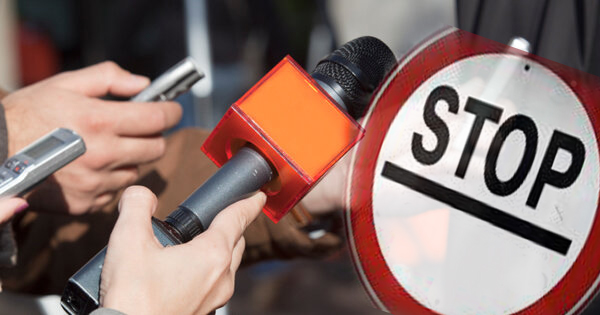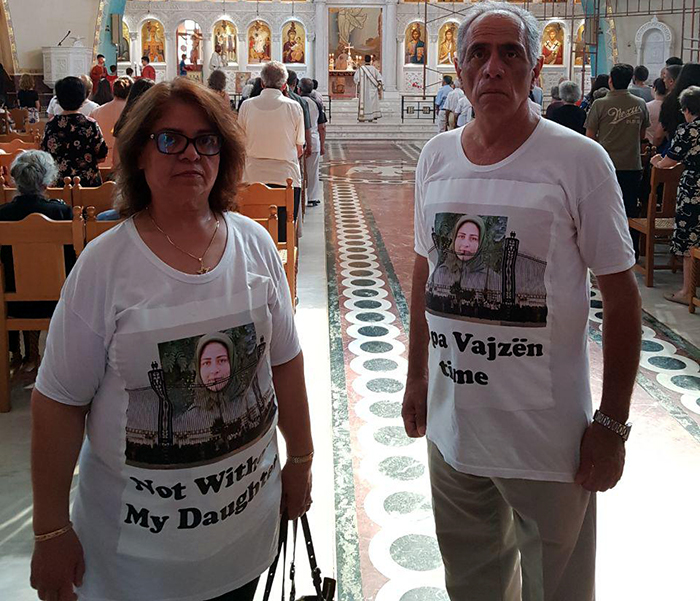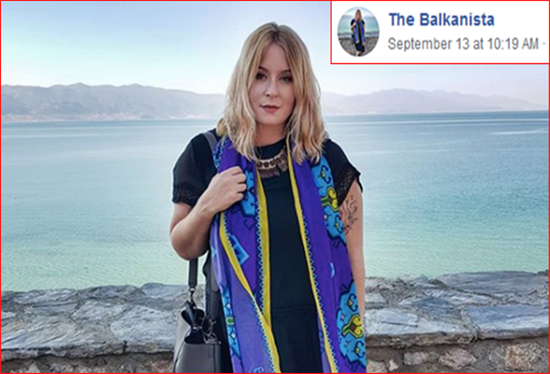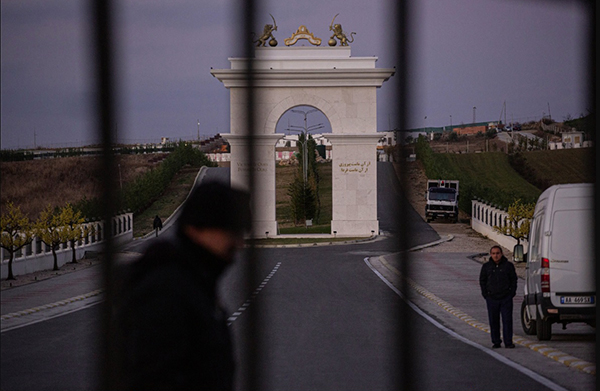The propaganda media of the Mujahedin Khalq Organization (the MKO/ MEK/ PMOI/ the Cult of Rajavi) published a claim against a Swedish journalist who had come to the group’s camp in Albania, labeling him as the spy of the Iranian Government. The ID cards of the Swedish journalist Ivan Blanco Bravo and two children of MEK members have been published on the MEK’s websites to verify their claim!
This is not the first time that the MEK accuses reporters and journalists of cooperating with the Islamic Republic. During the past decades, there were very few journalists who could manage to enter the MEK’s headquarters.

Actually, journalism is based on certain ethical principles that could terribly risk the MEK’s character. “Ethical Journalism Network” compiles five core principles of ethical journalism: 1. Truth and Accuracy, 2.Independence, 3. Fairness and Impartiality, 4. Humanity and 5. Accountability. Therefore, if an independent journalist wants to seek for the truth concerning humanity and fairness in the MEK’s headquarters, he will be responsible enough to transfer the evidences and the reality he or she witnesses in the camp. This is the conflicting point between the MEK and journalists. Although the MEK authorities have made efforts to portrait their establishment as a democratic entity made of freedom fighters, the realities have always leaked from the cult-like structure of the group.
June 13th, 2003 might have been the first time that the MEK authorities found out that the arrival of journalists in their camps will result in a disaster for them even if they take care for all elements of a democratic gesture. The date is the day a correspondent of the New York Times, Elizabeth Rubin published her revealing report on the life inside Camp Ashraf, Iraq. The MEK leaders had allowed Rubin to enter their large base in Iraq showing her different parts of the camp. She was received by a group of members running general interviews. Everything was under the supervision of the group authorities but finally the title of the published article turned out to be: “the Cult of Rajavi “. Rubin wrote a very detailed report of what she saw and heard in Camp Ashraf and frankly described MEK members in the camp as “a slight march to their gaits as at a factory in Maoist China”.
Since then, the MEK leaders seemed to be more cautious about the entrance of any person who is involved with mass media in any way. They do not allow any journalist to enter their camps unless they make sure that he or she is completely coerced to portray an ideal picture of their so-called freedom fighters.
Therefore, those many journalists and reporters who sought to discover the truth of the world inside the MEK and to verify the testimonies of defectors, have been always attacked by the MEK authorities; they were labeled as Iranian spies and harassed by the guards of the group’s camps.
One of the most recent accounts of such attitudes towards journalists took place in 2018. Lindsey Hilsum of the British Channel 4 TV tried to film a documentary of Camp Ashraf 3 in Manez north of Tirana but she was barred by the Abanian guards of the camp. Some of the group members came to the barbed wires and called her “terrorist” and “Iranian spy”. In September 2018, Hilsum published an eleven-minute video report titled “The shadowy cult Trump advisors tout as an alternative to the Iranian government”. She described the MEK as a political religious cult that brainwashes its members; forces celibacy and oppresses dissent.
The International editor of Channel 4 who did not succeed to access the inside of the MEK’s base had to listen to the testimonies of those who have left the group. So, she interviewed the Mohammadis, the parents of Somayeh.

Somaye Mohammadi’s Parents – Tirana – Albania
They were active in Albania at that time making efforts to visit their daughter in the MEK. Hilsum’s report also shows Somayeh’s parents being attacked by the MEK agents in the streets of Tirana.
Linda Presley and Albana Kasapi are BBC correspondents who went to the gates of Ashraf 3 last year. They were not allowed to enter the camp so they restricted their report to the interviews with defectors of the group who reside in Albania and with Albanian authorities. In November 2019, they published a report titled, “The Iranian opposition fighters who mustn’t think about sex”. In their article, they clarified:
“Uninvited journalists are not welcome here. But in July this year, thousands attended the MEK’s Free Iran event at the camp. Politicians from around the globe, influential Albanians and people from the nearby village of Manze, joined thousands of MEK members and their leader, Maryam Rajavi, in the glitzy auditorium. US President Donald Trump’s personal lawyer, Rudy Giuliani, addressed the crowd.”

also read: MEK Terrorist Cult Members In Albania Who Mustn’t Think About Sex
The journalists also stated that the BBC was not able to put any of this to the MEK, because the organization refused to be interviewed. Despite, all of these precautions that the MEK leaders take care about, sometimes the invited journalists do not act the way the leaders expect. Alice taylor is the British journalist who lives in Albania.
She was invited to the MEK’s grand gathering in Ashraf 3 in August 2019. She then published her observations of the MEK’s annual grand gathering in Balkanista weblog and her tweeter account under the title “My Day with the MEK”. Her account simply reveals crucial facts about the internal structure of the MEK. For example, she writes about the way she was first received at the event:
“The security guard confiscated my lipstick, face powder, cigarettes, and lighter and put them in a plastic bag, advising me I could collect them afterwards. They tried to confiscate my mobile phone as well, but I argued that having a one-month-old daughter at home, I needed to be contactable. A male MEK member was called over and after pleading my case, I was allowed to take my phone inside on the condition I switched off the internet (I didn’t).”
When she first introduces herself as a journalist to one of the event organizers, she was faced with anger. She got shocked to hear the man telling her “who the hell told you to be here?”. She realized that there were no other journalist, reporter or TV staff in the hall. She just saw a few cameramen and photographers whom she was sure they were MEK members. Alice who had been invited to the event by one of the female commandants of the group, left the gathering after a few hours. Fed up with the repetitive speeches “broken up by periods of coordinated chanting and flag-waving with each outburst as frenetic and enthusiastic as the one before”, she did not answer the Mujahed woman’s consequent phone calls.
And ultimately, another journalist from the New York Times entered Camp Ashraf 3 in Albania. Patrick Kingsley waited for hours in front of the camp before he was allowed to enter. His presence in Ashraf 3 was considered a new opportunity by the MEK leaders to correct the impressions of the former NYT’s journalist Elizabeth Rubin. However, their efforts to portrait the camp as a nice-looking place embellished with museums, gym, music studio and coffee shop, did not work.

Playing chess at the camp.Credit…Tara Todras-Whitehill for The New York Times

A street inside the camp.Credit…Tara Todras-Whitehill for The New York Times
They tried to convince Kingsley and his photographer colleague that the group members are freedom fighters who are friendly and peacefully devoted to the group’s cause: the freedom of Iranians. But his report published on February 16th 2020, revealed new dimensions of the life of whom he called “Highly Secretive Iranian Rebels”. He described his “tour” in Ashraf 3 as “series of interviews, propaganda sessions and tours”.
Kingsley believes that the MEK leaders allowed him to enter the camp because they “perhaps hoped to correct the impression left by previous journalistic encounters” about 17 years ago. According to Kinsley Rubin’s “subjects spoke from a rehearsed script, and she was barred from talking to people in private”. So Kingsley was allowed to interview Somayeh Mohammadi in private. The outcome was obvious. As before, Somayeh denies her parents’ desire to meet her accusing them of being the Iranian regime’s agent.
However, the NYT’s correspondent does not stop challenging the group. When he asks Ali Safavi about the whereabouts of Massoud Rajavi, the disappeared leader of the MEK, he answers, “Well, we can’t talk about that, that’s … ”. “He trailed off, staring at his feet,” Kingsley writes.
In his two-day tour in Ashraf he does not see more than 200 people around the camp although he was told that the group has 2500 members. He thinks that the rest are isolated. Like any other independent journalist Kingsley decides to interview ten of many defectors of the MEK who live in Albania. Based on their testimonies, he writes of the MEK’s cult-like structure and the troll farm of the group whose job is to launch propaganda against the Iranian government on the Internet.
He also interviews certain US army officials who were in charge of the MEK camp in Iraq after the US invasion. The MEK authorities suggested some army officials who trust but as Kingsley tweets: “But I was keen to find former US officials who no longer have ties with the MEK. They told a very different story.”
Capt. Matthew Woodside, a former naval reservist who oversaw American policy at the Iraqi camp between 2004 and 2005, was not one of those whom the MEK suggested. “I find that organization absolutely repulsive,” Captain Woodside told Kingsley. “I am astounded that they’re in Albania.”
After the publication of the report, Kingsley tweets some additional explanations about his observations that exposes more revelations about the dark life in “the Cult of Rajavi”. For instance, he tweets: ‘’naturally, they all denied most of what is said about the group. They said celibacy, forced divorce and rejection of family life is just a necessary part of overthrowing the Iranian government. One admitted the self-criticism. One admitted it the corrected himself. The rest denied.“
also read:New York Times Questions Presence of MEK in Albania
Therefore, as the mass media and social networks are highly effective to transfer the news, the presence of an independent journalist inside or outside the MEK’s headquarters is totally against the interests of the group and eventually they are all labeled by the MEK leaders as the agents of the Iranian intelligence. The leaders are so terrified of journalists that they accuse a son –who wants to visit his mother in the group—of being the Iranian agent because he is accompanied with a Swedish journalist. This is the absolute right of any child to see his or her mother even though their previous unsuccessful efforts to visit their mothers have made them use mental pressure by bringing a journalist with them.
Mazda Parsi


